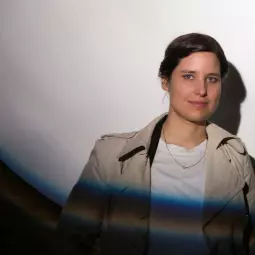Biography
Laura Kuch is a conceptual artist who lives and works in Germany. She studied Visual Communication at the HfG Offenbach, University of Art and Design, and Fine Art at the Städelschule Frankfurt, Academy of Fine Art where she graduated 2008 as Meisterschülerin of Prof. Tobias Rehberger. She’s currently finishing her MPhil in the practice-led Fine Art research programme at the Slade School of Fine Art, UCL, London.
Laura is alumna of both the German Academic Exchange Service DAAD and the German National Academic Foundation. Exhibitions include various solo and international group shows, amongst others Galerie Lorenz Frankfurt, Nassauischer Kunstverein Wiesbaden, Federal Exhibition Hall of Germany Bonn, The 2nd Moscow Biennale, 4th Gothenburg Biennale, Centre of Contemporary Art Prishtina, Kunsthalle Luzern and Arts Depot London. Conference presentations include: Romantic Intermediality, University of Helsinki, 2011;Conference on Practice-Based Research in Art and Design, Bauhaus University Weimar, 2011; Art as a mode of enquiry, The Ruskin School Oxford, 2012; New Perspectives on the Romantic Period, Tate Britain, 2012; Wonder in Contemporary Art Practices, University of Newcastle, 2013. Besides she gives workshops in relation to her practice and works as a visiting lecturer.
ARTIST STATEMENT:
IN SEARCH OF THE BLUE FLOWER
‘The world has an original ability to be enlivened through me. (…)
I have an original tendency and ability to enliven the world.’
‘The world must be romanticised. In that way one finds original meaning again. (…) By giving what is common an elevated meaning, the ordinary a mysterious aspect, the familiar the dignity of the unknown, the finite the appearance of infinity,
thus I romanticise it.’
(Novalis, Fragments, 1798)
The Blue Flower functions as a metaphor for wonder and the ineffable that can never be satisfyingly described with words. It first appeared in the unfinished novel Heinrich von Ofterdingen by the early Romantic writer Novalis in 1802 and became a central symbol in the literary and philosophical movement of German Romanticism. At the beginning of Novalis’ novel the young protagonist Heinrich wakes up from having a dream about a mysterious blue ‘wonder flower’. Filled with a deep longing to find it he sets forth on an actual as well as a spiritual journey to become a poet. Yet the Blue Flower remained forever unattained as the novel was never finished due to Novalis’ early death.
I have been searching for the Blue Flower for a long time, encountering the world as a Romantic conceptual artist. Once in a while I catch a glimpse of it, inducing me to continue my perpetual wandering despite knowing that truly this flower can never be picked. But where to look for the ‘wonder flower’ today, you might ask, after the last terra incognita on the globe has been explored; after what the sociologist Max Weber called ‘the disenchantment of the world’ brought about by the Enlightenment and Modernity?
Wonder today, I believe, lies in the poetic potential of the ordinary. What constitutes my art practice is insisting on and pointing out the poetic within the everyday and seemingly familiar things, thereby creating a poeticised or romanticised version of themselves. As wonder objects they become a part of my Wunderkammer collection – an object archive of which I am the creator and collector at the same time. Wunderkammer translates as wonder-chamber and is the German equivalent to a cabinet of curiosities. The historical Wunderkammer collections consisted of a wide range of wondrous natural history objects and artifacts. Presentation and content of the Wunderkammer depended on the collector’s individual preferences and represented a kind of visual-lyrical interpretation and appropriation of the world. Although the Wunderkammer is originally a Renaissance concept, I recognise a very Romantic idea behind it: to wonder and to acknowledge the miraculous is the precondition to discover the poetic within things.
Displayed and (re-)arranged in an ongoing series of Wunderkammer installations my wonder objects serve as elements of a body of visual-conceptual text. This text evolves in space as if written on a three-dimensional sheet of paper. It’s an ever-altering, arabesque dialogue in a Wunderkammer of the now, exploring the question of where and how we can find meaning – even, or maybe especially, within the most ordinary things.
 Share / Save
Share / Save





